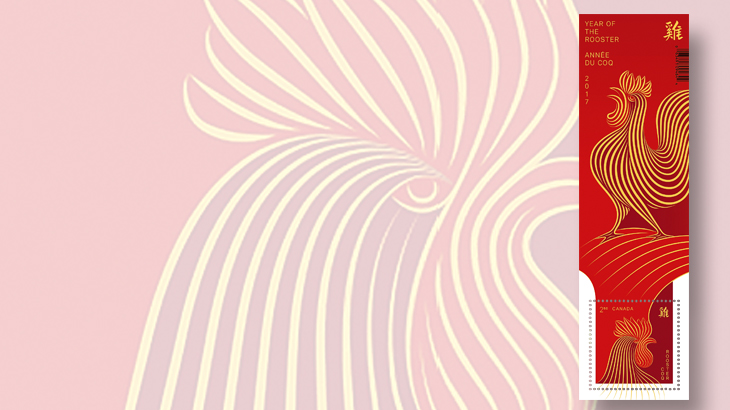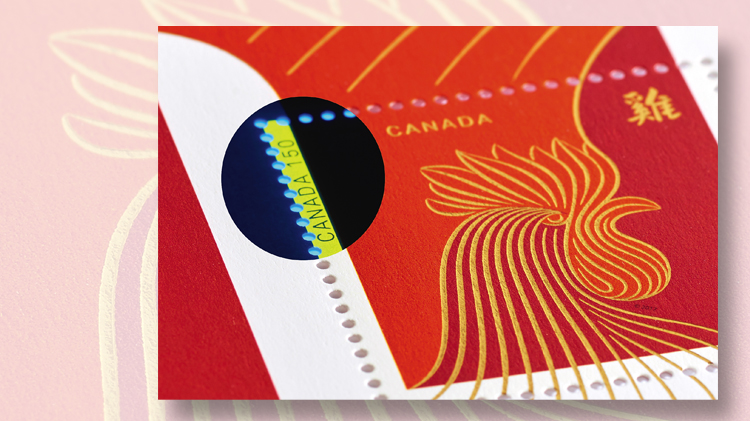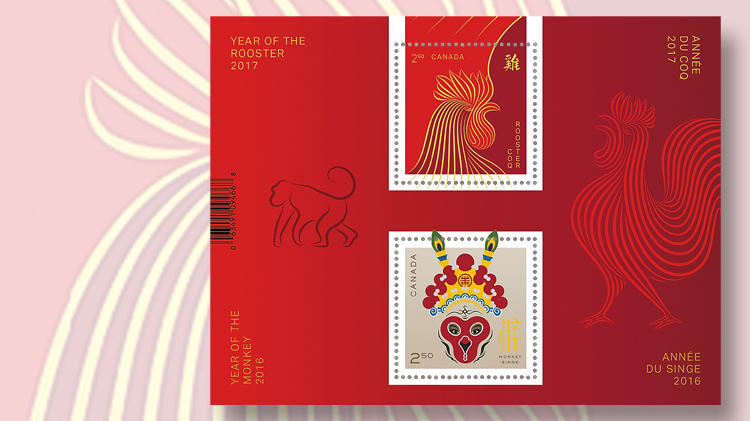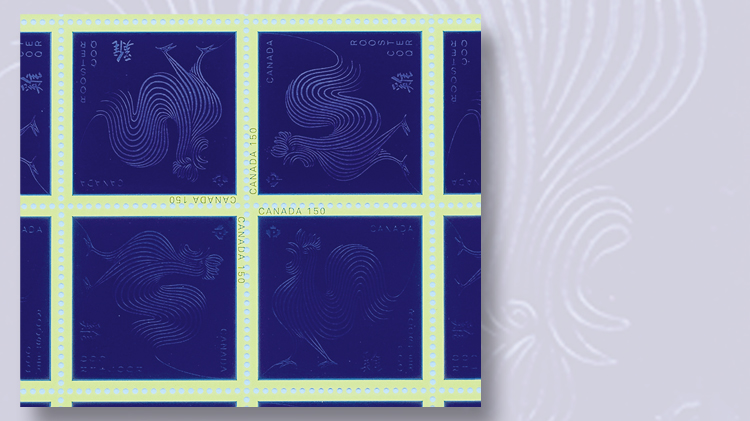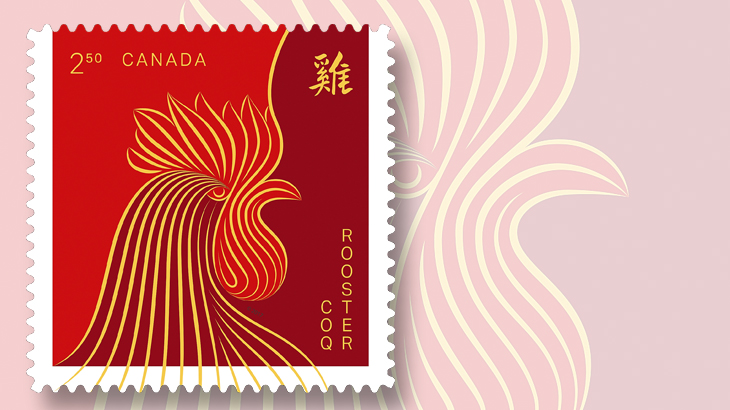World Stamps
Canada hides sesquicentennial references in its Year of the Rooster stamps
By Denise McCarty
Canada Post is hiding references to the 150th anniversary of Canada’s confederation in all of its 2017 stamp issues, starting with the Year of the Rooster on Jan. 9.
Jim Phillips, director of stamp services for Canada Post, said in Details (Canada Post’s publication for collectors): “It’s a special year, so we wanted to do something fun, interesting, even a bit challenging for collectors and consumers and give everyone a reason to take a closer look at this year’s philatelic offerings. As such, every stamp that comes out in 2017 will have a special reference to Canada’s sesquicentennial.”
Some of the references will be easy to spot, while others might be more challenging, according to Phillips. He added that all of them will be revealed in issues of Details.
For the Year of the Rooster issue, the references appear in tagging around stamps in a pane of 25, a booklet, and the uncut press sheet.
Connect with Linn’s Stamp News:
Sign up for our newsletter
Like us on Facebook
Follow us on Twitter
The Year of the Rooster is the ninth issue in Canada Post’s current 12-year Lunar New Year series, which began with Year of the Ox stamps in 2009 (Scott 2296-2297).
The Year of the Rooster issue includes two stamps: a nondenominated domestic “P” permanent-rate stamp (85¢) sold in booklets of 10 and panes of 25; and a $2.50 international-rate stamp available in booklets of six and two different souvenir sheets. Two postal cards, one imprinted with the permanent-rate design and one with the international-rate design, also were issued.
Both stamps are gold and red, and feature different images of symbolic roosters. Each design also includes the word rooster in Chinese (ji), French (coq), and English in the lower right.
Paprika, a firm in Montreal, designed the stamps, using calligraphy by Albert Ng.
Lowe-Martin printed the stamps by lithography with foil stamping. The stamps are square, measuring 32 millimeters by 32mm.
Canada Post describes the design of the domestic-rate stamp as an undulating pattern featuring “the bird in full form — its crest puffed out with pride.”
The rooster’s “stately profile” is captured in gold lines on the $2.50 stamp, according to Canada Post.
One souvenir sheet, measuring 40mm by 140mm, contains a single $2.50 stamp at the bottom. The selvage above the stamp includes the rooster image from the domestic-rate stamp and inscriptions relating to the year of the rooster.
The second souvenir sheet, which measures, 118mm by 90mm, includes the $2.50 Year of the Rooster stamp plus the $2.50 Year of the Monkey design from 2016 (Scott 2885). Canada Post calls this a “transitional” souvenir sheet.
The booklet stamps are self-adhesive, while those in the pane of 25 and the two souvenir sheets have moisture-activated gum.
The stamps in the pane of 25 are rotated in relationship to each other on the pane to complement the “wavy design,” according to Canada Post.
This is the first time that Canada Post has used such an arrangement. The United States Postal Service used a similar layout for the Jimi Hendrix pane of 16 issued in 2014 (Scott 4880).
Included in the margin of Canada’s Year of the Rooster panes of 25 are different well wishes and blessings for the new year in the four corners, images of the 12 animals of the Chinese zodiac (along the bottom), and Canada’s sesquicentennial logo in gold (center bottom).
In addition, under ultraviolet light the words “CANADA 150” appear dropped out of the tagging between the second and third stamps in the bottom two rows of the pane, according to a diagram in Details.
The same inscription also can be seen when looking at the booklet of six $2.50 stamps under ultraviolet light. It is located on the left side of the middle stamp in the top row.
The uncut press sheet contains 12 of the scroll-shaped souvenir sheets with a single $2.50 stamp in three rows of four. Canada’s 2017 sesquicentennial image is at the bottom right of the press sheet, with a hidden sesquicentennial reference on the fourth souvenir sheet in the top row.
Printing quantities are 80,000 panes of 25 of the permanent-rate stamp; 270,000 booklets of 10 of this stamp; 100,000 booklets of six of the $2.50 stamp; 200,000 souvenir sheets of one $2.50 stamp; and 100,000 souvenir sheets of two. Canada Post also is offering 8,000 uncut press sheets.
Canada Post will service 30,000 official first-day covers bearing the permanent stamp (Canada Post item 404030121) and 25,000 FDCs for the souvenir sheet of one (item 404030144). The FDCs will bear Vancouver, British Columbia, postmarks.
The pane of 25 permanent stamps is Canada Post item 404030107, the booklet of 10 is item 414030111, the booklet of six $2.50 stamps is item 414031111, the souvenir sheet of one is item 404030145, and the souvenir sheet of two is item 404031145. The uncut press sheet is item 404030149.
The postal stationery items are 262459 for the permanent-rate postal card, and 262460 for the international-rate postal card.
Canada Post stamps and related items are available from www.canadapost.ca/shop. Stamps and FDCs are available by mail order from Canada Post Customer Service, Box 90022, 2701 Riverside Drive, Ottawa, ON K1V 1J8 Canada; or by telephone from the United States or Canada at 800-565-4362, and from other countries at 902-863-6550.
They also are available from many new-issue stamp dealers, and from Canada Post’s agent in the United States: Interpost, Box 420, Hewlett, NY 11557.
MORE RELATED ARTICLES
Headlines
-
US Stamps
Oct 7, 2024, 3 PMMcMurtrie dismissed as APS education director following Sept. 21 arrest
-
US Stamps
Oct 7, 2024, 12 PMVasiliauskas named president of Mystic Stamp Co.
-
US Stamps
Oct 6, 2024, 5 PMApgar souvenir card available
-
US Stamps
Oct 6, 2024, 4 PMFirst Continental Congress and U.N. stamps receive Scott catalog numbers
